⌘F is a conversation series focused on the presentation of time-and web-based artwork. These interviews start with a set of fixed questions that trace the effects of worldwide quarantine on artistic practice and later expand upon a single work in detail. This week’s ⌘F invites conversation with Clement Valla. Valla is a New York-based artist whose work considers the way computer vision systems apprehend the world, and the way in which automated image production entangles people and things in increasingly complex ways.
The work we are discussing today is pointcloud.garden. To access the work, please click here. Read more about this work below.
**
What effects has self-isolation had on your practice now that we are confined to our homes and have limited interaction with others?
The pandemic has intensified some of the things I was already trying to work through. Firstly it’s intensified the time I spend outdoors, in parks and gardens, simply observing nature. There’s not much else to do right now, so ‘going out’ means going outdoors. I felt like I’ve observed the changes brought about by this spring more-so than at any other time.
Simultaneously, the pandemic has intensified my screen use— it’s the principal way to connect with friends and family. So it’s these two seemingly contradictory tendencies that are intensified. The third intensification has to do with being alone with my thoughts more. There’s not a pressing urge to fill all of my time up *doing* things. So I have more space and time to observe my own responses to the natural world and to the intensification of screen life. So there’s a funny overlap between these things that I’m trying to work through: technological or screen based pictures of nature and how I respond to them, emotionally, intellectually, and bodily.
One clear difference is the way in which a screen demands attention but a garden does not. And yet I can spend much more time in observing a garden than being on-screen without feeling completely drained, and tired, and often slightly buzzed and annoyed. It’s an interesting challenge to try and make an on-screen image that suggests casual observation rather than demands attention. A quiet kind of picture that just *is*.
In some recent video work I was playing with the idea of video as a background furnishing, as a wallpaper. During the pandemic I wanted to continue that trajectory with an on-screen moving picture that is slow, calm, quiet, meant to be absorbed almost as background. Something that might solicit the same kind of attention as a campfire or a brook. I think it’s a similar idea to artist Rafael Rozendaal who describes his websites as waterfalls. Something on screen that offers a change of pace from video chat and social media.
So I’ve been working on a new series of moving pictures, presented as a collection online at pointcloud.garden. All of the pictures are composed of 3d scans of gardens and flowers.
To be more precise the pictures are of point-clouds, the raw data layer that underlies 3d scans and is the basic building block for contemporary computer vision. A point cloud is a collection of points in space, sometimes with color information. Each point has been captured by sensors and software. Self-driving cars, aerial scans, drones, and most all forms of ‘computer vision’ rely on point clouds.
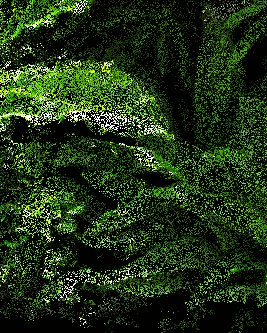
Gif of an early study for pointcloud.garden, 2020
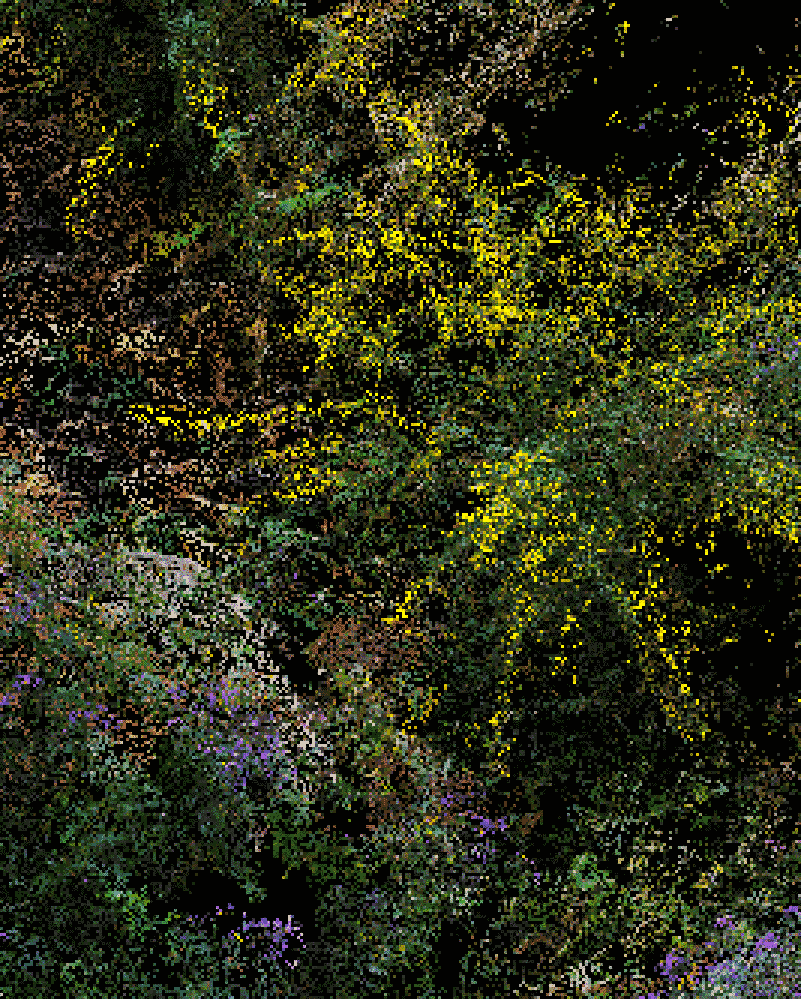
Detail gif of Goldenrod and Meadow Flowers, Fort Greene Park, from pointcloud.garden, 2020
So in some sense I’m trying to create a picture to elicit a particular kind of human attention and response, but the picture is created by and composed of algorithms, software and data. And to some degree these can be antithetical, but I’m trying to make sense of the human-machine axis in ways that don’t anthropomorphize machines or reduce humans to computers. Something more productive, more hopeful, where the differences and the gaps between human and machine ‘vision’ produce surprising and fruitful new ways of looking at the world.
The pandemic has also provided time to reflect on exactly what I do as an artist – how I work and what my role is. And something I keep questioning is the central role usually ascribed to the artist. I work with so many things that have their own logics, rules and processes, like computers, digital cameras, and all the software I use that is the joint creation of so many people. In some ways I’m more of a simple operator of a complicated picture-making apparatus. I’m not the prime agent of it’s aesthetic, I’m merely trying to steer it in a particular direction. Something that’s stuck with me is when (Vilém) Flusser says that artists aim at making improbable images within their apparatus.
So ultimately the way I work is with pre-existing software and digital apparatuses, connected to sensors, fabrication and printing technologies. I think of them as super simple ecologies when they are combined together. What I do is try and seed these processes with different things and see what happens. Some things grow completely fine on their own and need no intervention from me at all—I’m simply left to discover really interesting forms. Some things need more work in tending to—pruning, pushing in particular directions. But I am following or flowing with all the nonhuman elements that participate in the creation of the artwork. And in that sense gardening actually becomes an apt metaphor for making art with technology. It’s a metaphor that foregrounds context and environment, that emphasizes slow repetitive work, steady observation, and that reduces the artist to simply being one agent among many in a rich ecosystem.
Are there online resources that have been particularly useful for you during this time?
Are.na. It’s the only “social media” I use anymore, and it’s like pinterest for nerds. I do a lot of visual collating and collecting around current interests, like computer vision and new forms of image making. You can see what I’ve been aggregating here.
Excerpt from Pointcloud.garden, 2020
The work we’re discussing this week is the debut of a new artwork, pointcloud.garden (2020). This is a recent web-based work. What drew you back to working online?
The point cloud studies I was working on at the end of last year and early this year were originally meant for prints. I also wanted to try an animated version as a follow-up to the Video Wallpapers (2019). Something really slow, calm, quiet, meant to be absorbed almost as background. Something that might solicit the same kind of attention as a campfire or a brook.
Excerpt from Video Wallpaper #1, 2019
The animation tests led me back to methods that could work online, so when the quarantine hit I decided to focus on ways of getting the pointcloud.garden(s) online, so I could share it with friends. I also wanted something online that is a change the pace from video chat and social media. Something to just look at.
Your practice encompasses a unique 3D scanning methodology that profiles a range of different environments. Most recently, your focus has turned to natural objects found in the field. How do you communicate the motion and texture of these objects after they have been removed from their environments? I’m thinking of your Video Wallpapers in contrast with the Point Cloud Series; one removes form from texture, while the later constructs form in the absence of scanned texture. Can you share how you view this procession of movement and texture?
Great question, thanks. TBH I’m relatively new to video, and I think my shift towards moving images comes from working with 3d scanning over the past decade. The 3d scanning I do is called photogrammetry. Basically, photogrammetry can extract 3d information from many photographs of the same subject – the more photographs from different points of view of the same subject the better.
So I guess the point is I’m just “breaking down” the software, and responding to each step in the translation in the different works. But I did make a gif… because why not.
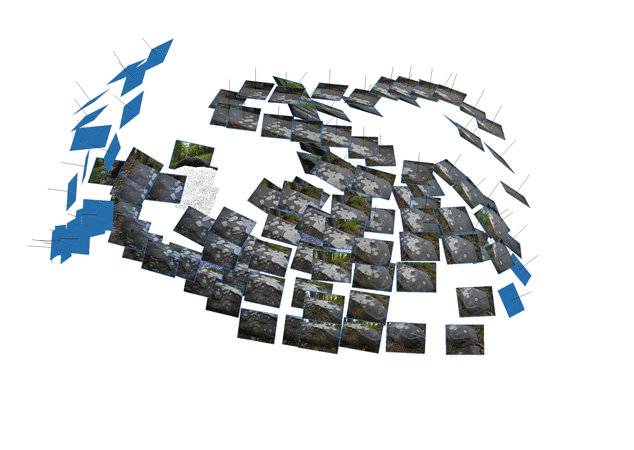
Photogrammetry sketch, 2020
So when I make a 3d scan, I’m the one moving in space, making sure to photograph my subject from many angles and points of view – I crouch down to get photos from low angles, and get up on my toes with arms outstretched to get some high shots. Basically just using my body to get the camera around the subject as much as possible. So I’ve experienced the subject pretty closely in time and in space when making a scan.
But the 3d scans themselves are still – frozen. So the different attempts at moving pictures is a way to translate my experience of making the scans.
Depending on the subject though, the videos or moving pictures end up being really different. So for example in the Video Wallpapers I am working with scans of rock ledges and cliff faces that are much bigger than I am. Each photo I take only covers a little bit of the rock face, and I have to slowly make my way up, down and across the rock face. I think that’s kind of reflected in the final video, a zoom in on the rock texture itself, where the image conforms to the rock and wraps around it, bringing the entire surface of the rock right up to the picture plane, so that the viewer can almost touch the rock. There’s no depth in those videos but hopefully a real sense of tactile texture. I think the GIF below from David Hockney’s Secret Knowledge videos captures what I was after.
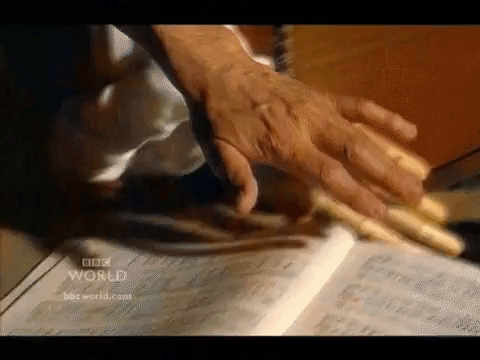
Video excerpt, David Hockey, Secret Knowledge
But for the pointcloud.garden pictures, I’m working with gardens and flowers. Delicate aggregates of leaves and petals and stems. And to photograph those I have to go over, and under, and around, and look through leaves and petals back to other plants and flowers. These are much more about depth and layers and volume. Using the point cloud data to depict these gardens allowed for volume and a particular kind of transparency – of seeing through – that felt very garden-like.
It reminds me of Simondon’s idea of brickmaking. Brickmaking is typically construed as applying a form (the rectangle) onto an inert material (clay). The ‘action’ is one sided. For Simondon the relation between form and matter are more complicated. The ‘form’ has to be materialized, usually as a wood mold, and the clay has to be prepared, cleaned, and kneaded in order to accept the molded form properly. The wood mold itself is not just abstract, but specifically adapted to work best with prepared clay. In other words both clay and mold inform each other to the point where they become compatible, and only then is a brick formed. Brickmaking is a process of coming together, not a process of applying form to matter.
So, sorry for the rough translation of Simondon, and for the digression. That idea of a coming together in order to produce something feels really appropriate here. The final outcome of the moving pictures in the Video Wallpapers is very much informed by the rock face itself. In pointcloud.garden, the gardens themselves have a certain compatibility with the point cloud representation. The pictures are the result of the technology and the subjects of that technology operating on each other and in finding compatabilities between the two. So the mode of technological representation finds a compatibility with the represented subject. They respond to each other, and I facilitate that – that’s my role. The gardens wouldn’t work in the flattened space of the Video Wallpapers, and the rock faces aren’t as compatible with the point cloud representation.
So once again it sort of leaves me in this funny situation where I’m just really lucky – I am just messing about enough with the technology, and attuned to my own responses and the subject matter, so that I stumble upon representation that cohere a whole bunch of different processes together, and hopefully elicit a human response.
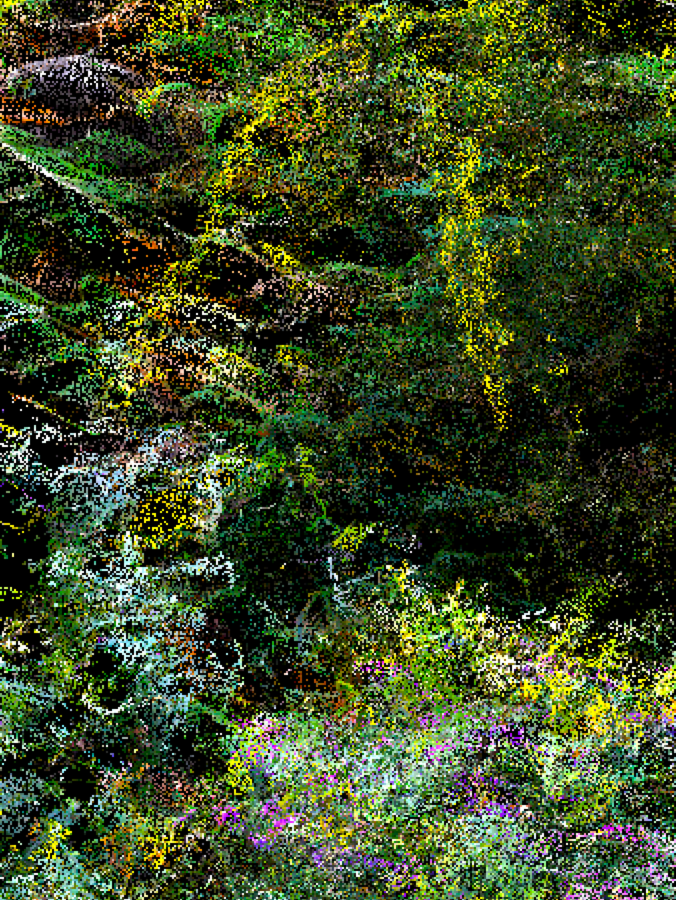
Detail of Goldenrod and meadow flowers, PointCloud.Garden series, 2020